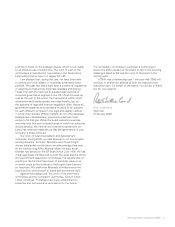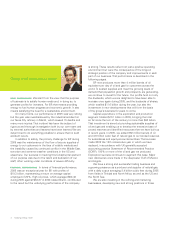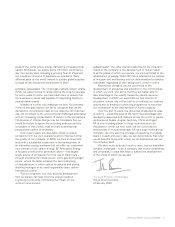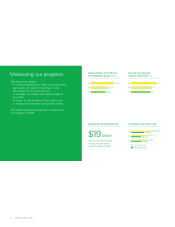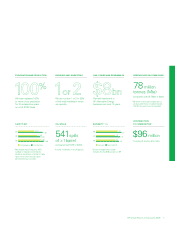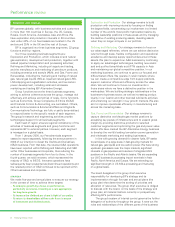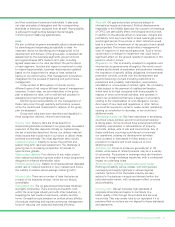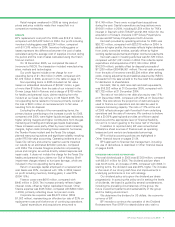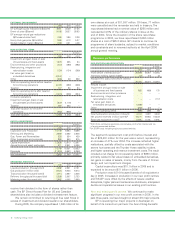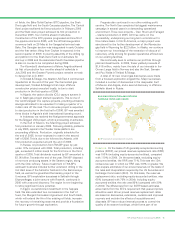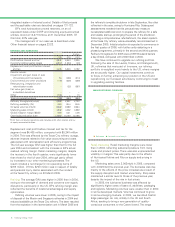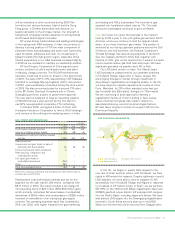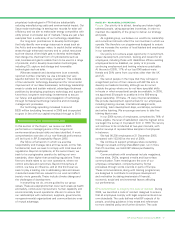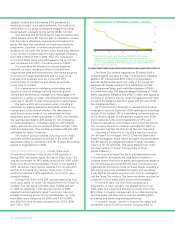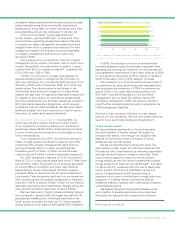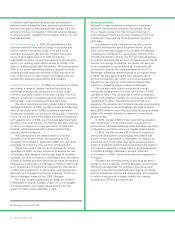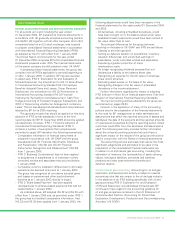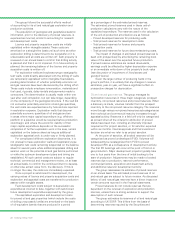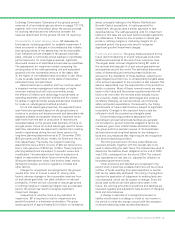BP 2005 Annual Report Download - page 15
Download and view the complete annual report
Please find page 15 of the 2005 BP annual report below. You can navigate through the pages in the report by either clicking on the pages listed below, or by using the keyword search tool below to find specific information within the annual report.
Progress also continued in our other existing profit
centres. The North Sea completed its biggest maintenance
campaign in several years in a demanding operational
environment. Three new projects – Clair, Rhum and Farragon
– started production in 2005. All three came on line
successfully, underpinning our long-term commitment to
this mature basin. In North America, a major project was
sanctioned for the further development of the Wamsutter
gas field in Wyoming for $2.2 billion. In Alaska, we continue
to improve our knowledge of the extraction of viscous oil
resources, while striving for greater operational efficiencies
on our existing facilities.
We continually seek to enhance our portfolio through
planned divestments. In 2005, these yielded proceeds of
$1,416 million, mainly from the sale of our interests in the
Ormen Lange field in Norway and also the Teak, Samaan
and Poui fields in Trinidad & Tobago.
A total of 12 new oil and gas discoveries were made
from a focused exploration programme. Major successes
included a number of discoveries in the deepwater Gulf
of Mexico and Angola, and a second discovery in offshore
Sakhalin Island in Russia.
BUILDING PRODUCTION AND RETURNS
THROUGH FOCUS AND CHOICE
BP exploration and production locations
Reserves On the basis of UK generally accepted accounting
practice (SORP), our proved reserves replacement ratio (RRR)
was 100% (including equity-accounted entities), compared
with 110% in 2004. On the same basis, excluding equity-
accounted entities, the RRR was 71%. This was the 13th
consecutive year in which our RRR was 100% or greater. We
also prepare estimates of our proved reserves on the basis of
the rules and interpretation required by the US Securities and
Exchange Commission (SEC). On this basis, the reserves
replacement ratio, excluding equity-accounted entities, was
68% (compared with 78% in 2004); including equity-
accounted entities, the ratio was 95% (compared with 89%
in 2004). The differences from our SORP-based estimates
arise mainly from the SEC’s requirement that year-end prices
should be used. All our proved reserves replacement ratios
are based on discoveries, extensions, revisions and improved
recovery and exclude the effects of acquisitions and
disposals. BP has a robust internal process to control the
quality of its reserve bookings, which forms part of an
BP Annual Report and Accounts 2005 13
oil fields, the Baku-Tbilisi-Ceyhan (BTC) pipeline, the Shah
Deniz gas field and the South Caucasus pipeline. The Central
Azeri project achieved its first production in February 2005
and the West Azeri project achieved its first production in
December 2005, four months ahead of schedule.
Construction of the BTC pipeline progressed and line-fill of
the pipeline started in 2005, with the official inauguration
ceremony held on 25 May at the Sangachal terminal near
Baku. The Georgian section was inaugurated in early October
and the first tanker lifting from Ceyhan is expected in the
second quarter of 2006. In-country assembly of the drilling rig
and platform for the Shah Deniz field is on schedule for
start-up in 2006 and the associated South Caucasus pipeline
is also on course to be completed during 2006.
The Kizomba B development offshore Angola achieved
its first oil production four months ahead of schedule in
July 2005 and the Greater Plutonio project remains on track
to deliver first oil in 2007.
In Trinidad & Tobago, the Atlantic LNG Train 4 commenced
liquefaction at the end of the year. The Cannonball gas
development, Trinidad & Tobago’s first major offshore
construction project executed locally, is due to start
production in the first quarter of 2006.
In Algeria, the carbon dioxide (CO2) capture system in
our In Salah gas project started operations. This is one of
the world’s largest CO2capture projects, providing emissions
savings estimated to be equivalent to taking a quarter of a
million cars off the road. The In Amenas project is expected
to start production in the first half of 2006. BP was awarded
three blocks in Algeria’s sixth international licensing round.
In Indonesia, we received the final governmental approvals
for the Tangguh LNG project, which is proceeding on schedule.
In the Gulf of Mexico, the Mad Dog project achieved
first production in January 2005. Following stability problems
in July 2005, repairs to the Thunder Horse platform are
proceeding offshore. Production, originally scheduled for
the end of 2005, is now expected to start in the second
half of 2006. This is due to be followed by Atlantis, with
first production expected around the end of 2006.
In Russia, oil production from TNK-BP grew by just
under 10% compared with 2004. Total production, including
gas, exceeded 2 million boe/d for the first time in the third
quarter of 2005. Total dividends received by BP amounted to
$1.95 billion. Towards the end of the year, TNK-BP disposed
of non-core producing assets in the Saratov region, along
with the Orsk refinery. Future investment in TNK-BP’s
upstream business includes further extension drilling in the
Ust Vakh area of the Samotlor field and in the Kammenoye
field, as well as the greenfield Demiansky project in the
Uvat area. BP’s exploration successes in Sakhalin through
Elvaryneftegas, a joint venture with Rosneft, continued in
2005 with a second discovery. The region is now beginning
to show significant future potential.
In Egypt, we sanctioned investment in the Saqqara
field. We also extended two concessions in the Gulf of
Suez, the Merged Concession Agreement and South Garib,
which will extend the life of the existing oil fields, increase
the recovery of remaining reserves and provide a foundation
for future growth through exploration.


